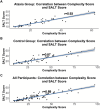Revisiting the Cerebellum's Linguistic Role: Evidence for Cerebellar Involvement in Expressive Syntax
- PMID: 40637927
- PMCID: PMC12245948
- DOI: 10.1007/s12311-025-01879-y
Revisiting the Cerebellum's Linguistic Role: Evidence for Cerebellar Involvement in Expressive Syntax
Abstract
The cerebellum's role in language remains unclear, though cerebellar damage may influence expressive language via neurological or compensatory mechanisms. This study investigated the syntactic complexity of spoken language in individuals with dysarthria due to cerebellar ataxia. Speech samples were collected via a picture description task from 26 individuals with cerebellar ataxia and 28 age- and sex-matched controls. Two complete sentences from each participant's picture description were selected for analysis and categorized by the presence of dependent clauses. A novel syntactic complexity scoring system, based on the developmental acquisition of parts of speech and validated against Systematic Analysis of Language Transcripts (SALT) scoring, was used to analyze a total of 108 utterances. The novel complexity scores showed high correlation with SALT scores, supporting validity. While overall syntactic complexity was higher in control participants (Cohen's d = 0.39), the difference was not statistically significant (p = 0.057). However, when analyzed by clause type, controls produced significantly more complex utterances for both independent and dependent clauses. Individuals with ataxia also produced fewer dependent clauses overall. Within the ataxia group, syntactic complexity was not associated with dysarthria severity, naturalness ratings, dysarthria impact, age, or sex. This study suggests a potential contribution of cerebellar dysfunction to reduced expressive syntactic complexity, based on significant group differences observed in specific clause types. Although the overall group difference in syntactic complexity did not reach statistical significance, the results highlight patterns consistent with a cerebellar role in language formulation. This work also introduces and validates a new tool for quantifying syntactic complexity in connected speech, which may support future research in disordered language production.
Keywords: Cerebellar physiology; Dysarthria; Speech-language pathology; Syntax.
© 2025. The Author(s).
Conflict of interest statement
Declarations. Competing Interests: The authors declare no competing interests.
Figures




References
-
- Ackermann H, Mathiak K, Riecker A. The contribution of the cerebellum to speech production and speech perception: Clinical and functional imaging data. Cerebellum (London, England). 2007;6(3):202–13. 10.1080/14734220701266742. - PubMed
-
- Baldo JV, Dronkers NF. Neural correlates of arithmetic and language comprehension: a common substrate? Neuropsychologia. 2007;45(2):229–35. 10.1016/j.neuropsychologia.2006.07.014. - PubMed
-
- Bates D, Maechler M, Bolker B, Walker S. lme4: Linear mixed-effects models using Eigen and S4. R Package Version. 2014;1(7):1–23.
-
- Ben-Shachar MS, Lüdecke D, Makowski D. effectsize: Estimation of effect size indices and standardized parameters. J Open Source Softw. 2020;5(56):2815.
-
- Bird S, Klein E, Loper E. Natural Language processing with python: analyzing text with the natural language toolkit. Sebastopol, CA: O’Reilly Media, Inc. 2009.
MeSH terms
Grants and funding
LinkOut - more resources
Full Text Sources

